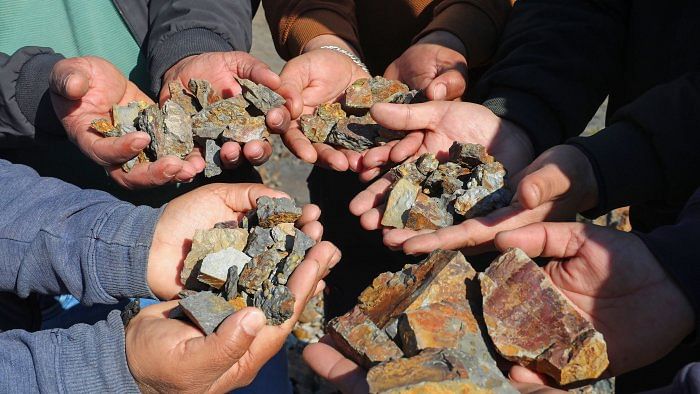
The Geological Survey of India’s recent announcement on the discovery of lithium deposits in the Reasi district of Jammu and Kashmir created a buzz among the clean energy and electric mobility ecosystems.
The quality is said to be top grade and the size of the deposit substantial. In India's quest for strategic minerals, it is no doubt a big find.
Despite the good news, experts caution that multiple technical and ecological challenges have to be overcome before commercial lithium mining can take off in India.
Getting a correct estimate on the size of the reserve is the first challenge. Though the GSI has inferred an estimate of 5.9 million tonnes – second to Chile’s 8 million tonnes – this is only a preliminary evaluation.
Also Read | Lithium in Jammu & Kashmir — a boon or a curse?
A better assessment on the size of the reserve will come in the next stage of exploration. But it is not clear at the moment how long the process will take, and whether the GSI will be the lead agency for the exploration.
“Lithium falls in the critical resource category, which was not earlier available in India. We were 100 per cent import dependent. The GSI study shows the presence of best quality lithium in abundant quantities in the foothills of Mata Vaishno Devi shrine at Salal village (Reasi)," said J&K Mining Secretary Amit Sharma.
Against the normal grade of 220 parts per million (PPM), the lithium found in J&K is of 500 ppm-plus grading.
The announcement comes three decades after geologists prospecting the mineral reserves of Jammu and Kashmir first reported “high lithium values in the samples collected from bauxite columns” in 1992.
Subsequently, in a 1999 report, two GSI scientists noted that “the prospect of lithium appears to be promising” in the Reasi belt, flagging high values of lithium “persistent throughout the belt”.
Even as the Union government is silent on why it took such a long time to announce what appears to be one of the world’s biggest reserves of lithium, energy researchers hope that an indigenous source of the mineral will help India move faster on the clean energy transition path and achieve net-zero by 2070.
A domestic reserve will also save a lot of foreign exchange, with India spending more than Rs 26,500 crore between FY 18-19 and FY 20-21 to import lithium and lithium-ion batteries. With a steep rise anticipated in the production of electric vehicles and scooters, and expansion of solar power, the demand for lithium is set to shoot up.
The Marlagalla–Allapatna sector in Srirangapatna taluk in Mandya district of Karnataka, and pockets of Jodhpur and Barmer districts in Rajasthan are other places where lithium was spotted by the GSI. But the quantity is much less as compared to the Jammu site.
“Having such a resource in India is in our favour, but we have to work hard to make a proper assessment and create a roadmap on processing once the initial euphoria is over. Otherwise, we would be back to square one and continue to depend on imports,” B K Mishra, former director of CSIR’s Institute of Minerals and Materials Technology, Bhubaneswar, told DH.
With GSI taking more than 20 years to move from reconnaissance (G4) to prospecting (G3) stage, experts say the agency and the government need to work hard to quickly progress to general exploration (G2) for better assessment of the shape, size and grade of the deposit.
Also, a clear picture is needed on the deposit’s depth to determine what kind of mining technology is needed, and whether the use of such technology is feasible and desirable in the earthquake-prone areas close to the Himalayas.
Since lithium is embedded inside bauxite columns, the central agency will now write to the Jammu and Kashmir administration, requesting the Union Territory to take up the general exploration as per the norm applicable for bauxite mining, explained a GSI official.
It can take up the G2 work only if a state or UT expresses its inability. Going by the pace of the Indian bureaucracy, this may take time. Bauxite mining is also power-intensive and the northern state will have to make arrangements for adequate electricity supply.
The announcement comes at a time when India is hunting for lithium in Argentina, Chile and Bolivia – the Lithium Triangle in the Andean Plains of South America – because of the growing demand.
The Narendra Modi government has set an electric mobility target of 30 per cent for private cars, 70 per cent for commercial vehicles and 80 per cent for two-wheelers and three-wheelers by 2030.
An alternative source will reduce dependence on China, which currently accounts for more than 50 per cent of global supply of lithium-ion batteries.
Australia with a vast lithium reserve is another country India is eyeing for cooperation. It remains to be seen whether the Khanij Bidesh India Limited, which is partnering with foreign companies on lithium prospecting and exploration, can successfully use the GSI announcement to secure a better deal for India, which does not have much experience in lithium mining.
